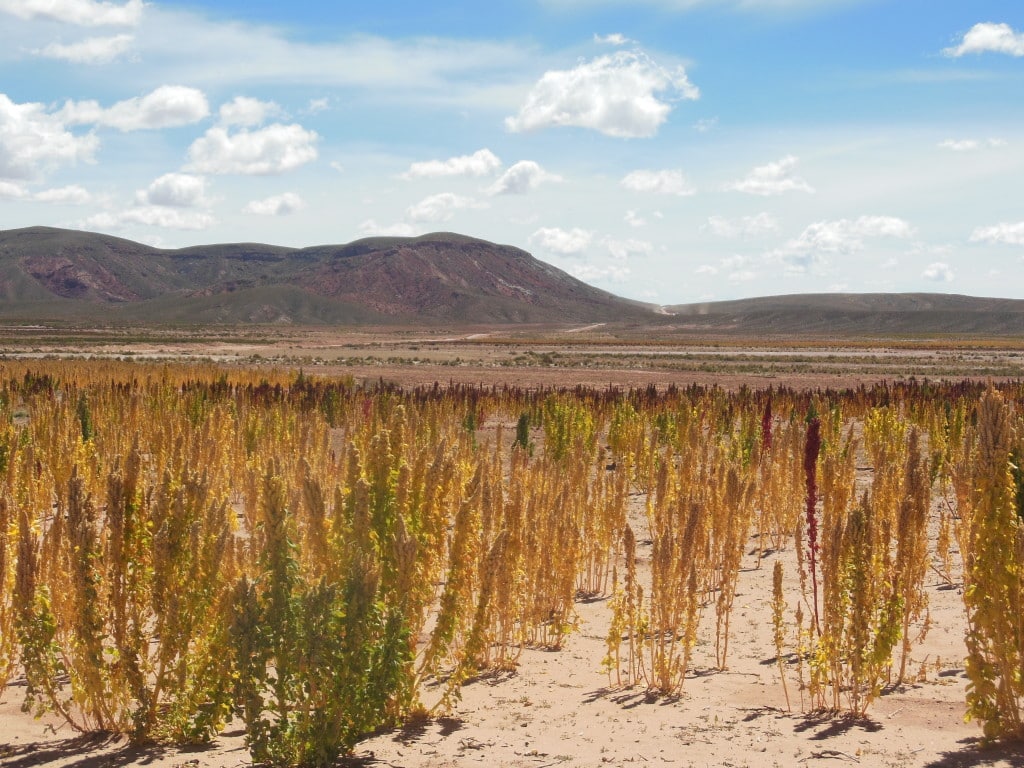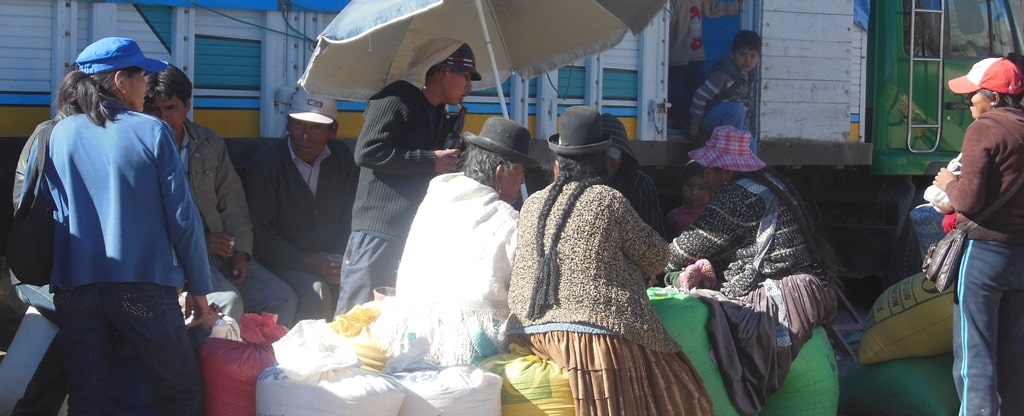Latin American geographer Alexander von Humboldt wrote in the beginning of the 19th century that quinoa was to ancient Andean societies what “wine was to the Greeks, wheat to the Romans, cotton to the Arabs.” Therefore, it is also often called “grano de los Inca” or “grano de oro” (“Inca-grain” or “golden grain”). In its history, quinoa has gone through the stage of being a staple food for Andean inhabitants, a period in which it had the reputation of being the ‘food of the poor’ and has developed into being one of the most expensive gluten-free carbohydrate products, being a ‘food of the wealthy’ (Quinoa: 4.85$/kg in comparison to white rice: 1$/kg or noodles: 1.20$/kg; Source: New York Times, 2011).
Quinoa is called the golden grain not only due to its appearance but also due to its many positive properties. In the FAO’s report “Quinoa: An ancient crop to contribute to world food security” the following are mentioned as outstanding intrinsic characteristics: First of all, quinoa has a broad genetic variability which allows for developing superior varieties in the future. Next to that, it has a strong adaptability to extreme climate and soil conditions. Further, its nutritional properties are outstanding since it is a rich source of proteins, phosphorus, calcium and iron and contains all important amino acids. Quinoa also is relatively low in production costs and lastly can be used in many diverse methods.
Nutritional properties of quinoa:
|
composition per 100 g dry weight |
Quinoa |
Rice |
Barley |
Wheat |
|
Proteins (g) |
16.5 |
7.6 |
10.8 |
14.3 |
|
Fat (g) |
6.3 |
2.2 |
1.9 |
2.3 |
|
Carbohydrates (g) |
69 |
80 |
80 |
78 |
|
Fiber (g) |
3.8 |
6.4 |
4.4 |
2.8 |
|
Calories (kcal/100g) |
399 |
372 |
383 |
392 |
Table: Nutritional properties of Royal Quinoa; Source: ANAPQUI 2012
These days, quinoa is popping up everywhere. The Andean countries Ecuador and especially Peru and Bolivia are maintaining their position as leaders of the worldwide quinoa exports. In 2008, Peru and Bolivia accounted for 92% (FAO, 2011) of total quinoa production. In 2013, the quinoa cultivated in Bolivia has increased from 34,156 MT (IBCE, 2013) in 2008 to 61,182 MT in 2013. More than half of it (57.4%) have been exported, meaning 35,108.4 MT (CABOLQUI, 2014). Peru produced around 45,000 MT (FAO, 2013) in 2013 of which 17,070 MT (SUNAT, 2013) have been exported. The Bolivian vice minister expects total production of 95,444 MT in 2014 (Víctor Hugo Vázquez) and it is suggested, that Peru would have the capacity of producing 650,000 MT (Angel Mujica from Minagri). Next to the main producing countries in the South-American Andes, quinoa is cultivated in Morocco, France, Canada and Pakistan. Our task is to keep you updated about exactly that development.
September, 2013.
 Quinoa growing in Uyuni, Picture: Annika Gabriel, March 2013
Quinoa growing in Uyuni, Picture: Annika Gabriel, March 2013
Picture above: Remco de Kluizenaar, 2013
Links
FAO’s International Year of the Quinoa, 2013 and general information: http://www.fao.org/quinoa-2013/en/
Bolivian website of the IYQ: http://www.quinuainternacional.org.bo/
Bolivian Chamber of Quinoa Exporters and Organic Products CABOLQUI: http://www.cabolqui.org/
Centre of the Promotion of Imports from Developing Countries CBI: http://cbi.nl/
Quinoa in Bolivia, http://infoquinua.bo/
Bioversity International provides a document with insightful information about the biodiversity and the context of Andean grains: Balancing market potential and sustainable livelihoods. Published in 2012. The document comprises detailed studies about the market potential of Andean grains, an analysis of livelihoods of quinoa producers in southern Bolivia, insight into small-scale quinoa processing technology and a screenshot of novel products, markets and partnerships in the value chains.
For people with more phantasy: https://www.youtube.com/watch?v=7dmjOjoog4A&feature=youtube_gdata_player
Bolivian Ministry of Development: http://www.agrobolivia.gob.bo/
Some news
-Quinoa in the Netherlands: http://www.biojournaal.nl/artikel/15517/Start-Nederlandse-quinoa-teelt
-Quinoa in India: http://timesofindia.indiatimes.com/city/hyderabad/Quinoa-holds-hopes-for-dry-Anantapur/articleshow/20387557.cms
-Quinoa in India, Factoria Quinua in CNN: http://edition.cnn.com/video/standard.html?/video/business/2013/11/05/globex-quinoa-grain-nick-parker.cnn&iref=allsearch&video_referrer=http://edition.cnn.com/se
-To understand how production and export in Bolivia and Peru have developed since 2008: http://www.la-razon.com/economia/Bolivia-Peru-segundo-cosecha-quinua_0_1936006499.html
Documents
Presentation of the Bolivian ambassador Roberto Calzadilla about the government’s role in the Bolivian quinoa sector in 2013. Presentation Quinoa, RC
Presentation about “Quinoa as an Opportunity” by the Peruvian Minister of Agriculture Milton van Hesse, 2013.
An insight into quinoa trade’s impact on people, planet and profit in the Bolivian Southern Altiplano, based on value chain analysis and relationship assessment between quinoa producers and exporting companies: “Royal Quinoa reigning the world – from food of the poor to the world’s superfood” Final_Thesis_AG_FTM_1.7 by Annika Gabriel
PhD thesis from Pablo Laguna, examining the rural development of indigenous quinoa farmers in Bolivia from a sociological point of view: “Mallas y Flujos – Collective action, social change, quinoa and indigenuous regional development” Tesis_Final_WUR
“Food Sovereignty and the Quinoa Boom”, a critical dialogue by Tanya Kerssen, 2013.
“Bolivian Quinoa Travels Beyond Borders“, summary of important facts about Bolivian quinoa, IBCE (Bolivian Institute for Foreign Commerce), 2013
Extensive book about “Collective property and organic, capitalist production: the case of quinoa in the Bolivian Southern Altiplano” by Enrique Ormachea and Nilton Ramirez for CEDLA, 2013. In Spanish!
Quinoa in the Netherlands:“Exploration of the Feasibility of a Dutch Quinoa Chain”, by Rens Kuijten.

